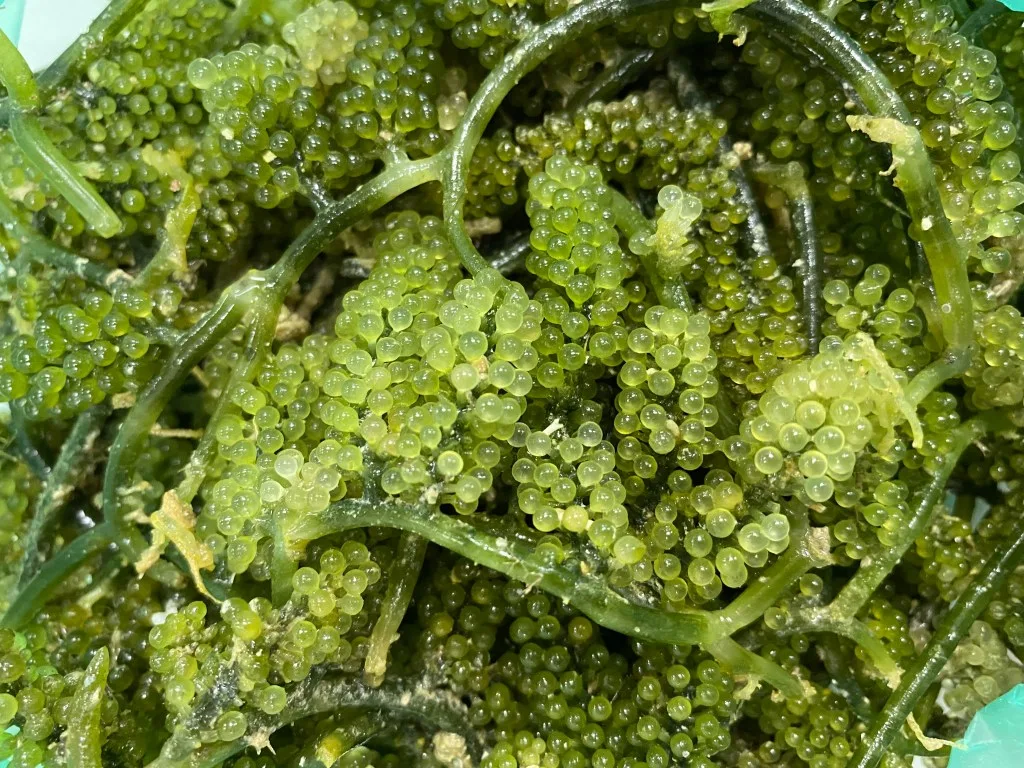You may think sea grapes are exactly what you think they are because of the name. But are they actually grapes? Or maybe they’re fish eggs?
Could they possibly be seaweed?
We’ve got the answers for you. Read on to find out all about this interesting food, where to find it, where to buy it, and if you should be eating them in the first place.
What Exactly Are Sea Grapes?
Sea grapes (not to be confused with the other seagrapes or “Coccolaba uvifera,” a flowery plant along tropical coastal beaches) aren’t actually grapes. And no, they aren’t fish eggs, either.
They’re a type of seaweed and are aquatic vegetable called sea grapes because of their appearance. The grapes are clusters of tiny green grapes along a stem. It may also look similar to caviar, but it’s, in fact, seaweed.
In Japan, they call it kubiretsuta, but it’s more commonly known as umi-budō. That translates from umi, meaning “sea,” and budo, meaning “grapes.”
Do Sea Grapes Have Any Health Benefits?
Seaweed has vitamins and minerals such as vitamins A, C, calcium, zinc, and iron. This is no different. If you have access to this sea grape, this could become a part of your daily diet. It would be a fun alternative to other vegetables while giving you the health benefits you expect.
Sea grapes are also a good source of omega-3 fatty acids and are low in calories. This may just be the world’s next superfood.
Pro Tip: Do you love trying new foods like sea grapes? Head to these 7 Most Unique Restaurants in the USA.

What Do Sea Grapes Taste Like?
Before eating sea grapes, you’ll need to give them a cold water bath for about five minutes, along with a rinse right before you eat them to reduce the saltwater taste.
Once done, you can eat them plain or add them to almost any dish. They are crisp and pop when you bite into them, giving off a salt of the ocean taste. Everything on the plant is edible, from the stem the grapes grow on to the grapes themselves.
Where Can You Buy Sea Grapes?
This green seaweed is actually a delicacy in many parts of Asia. Also known as latô, arosep, or guto, sea grapes are mostly found in Japan, especially in Okinawa. That’s where the majority of sea grapes come from. But you can also find them in the Philippines and Malaysia.
If you want to try sea grapes for yourself, you can find them fresh in many Asian restaurants or markets as they are a part of the local cuisine. Or, if you live outside of Asia, you can buy dehydrated sea grapes online or through specialty Asian stores across the U.S. and other countries.
How Expensive Are Sea Grapes?
According to an article in Taiwan Today, regarding sea grapes as a cash crop, “The plant is prized among the Japanese, who pay as much as NT$2,000 (US$62.40) per kilogram for it.” How much will it cost you to add this green caviar to your sushi or local rice dish when visiting the Philippines or Japan? That all depends on the restaurant or street vendor you visit. Dehydrated sea grapes bought online might be your best and cheapest option, with prices starting around $18 for 4 ounces.

Are Sea Grapes Seasonal?
Contrary to what many might believe, plants that grow in the sea have a growing season, just like plants that grow on land. Sea grapes are no different. The season for this specific seaweed is generally from January to May.
So if you’re planning on trying to find fresh sea grapes to add to your cuisine, plan your Asian tour around those months.
Can You Grow Sea Grapes At Home?
Sea grapes grow naturally in the sea about six meters below sea level. They do well in the temperate coastal regions of the Indo-Pacific. But this doesn’t mean you can’t grow them home. Attempting to create the same type of growing environment for this delicacy is difficult, but you can do it.
You’ll need the correct salinity level, appropriate lighting, water current, and the proper amount of minerals to grow viable sea grapes.
Along with that, you’ll also need a controlled environment for proper growth. With all of these specific factors, hopping on a plane to Japan might just be easier.
Pro Tip: Should you eat sea grapes on your travel day? We uncovered what foods you should Avoid on Your Travel Day.
Should You Try Sea Grapes?
So, maybe your best bet isn’t flying to Japan or growing your own, but if you can access umi-budō, you might want to give it a try. Whatever you call them, grapes, green caviar, or seaweed, they are sure to be an adventure for your taste buds.
Plus, who says you have to eat them all by themselves? Try them with soy sauce or vinegar or in a sesame sauce. You can also add them to a salad or a rice bowl, or even as a complement to sushi.
How about it? Are your taste buds up for the adventure? Tell us in the comments!
Discover the Best Free Camping Across the USA
To be honest with you, we hate paying for camping. There are so many free campsites in America (with complete privacy).
You should give it a try!
As a matter of fact, these free campsites are yours. Every time you pay federal taxes, you’re contributing to these lands.
Become a FREE CAMPING INSIDER and join the 100,000 campers that love to score the best site!
We’ll send you the 50 Best Free Campsites in the USA (one per state). Access the list by submitting your email below: